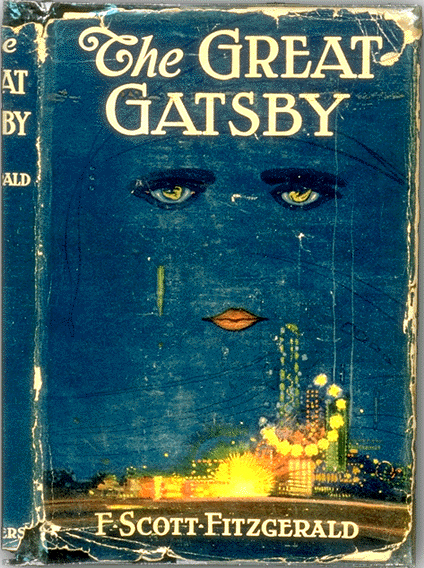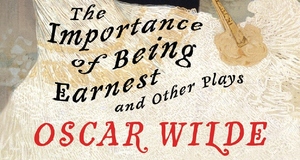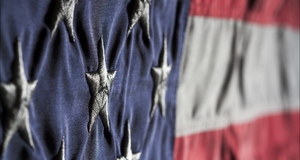The Great Gatsby's Relation to and Importance as a Work of Art
By
2011, Vol. 3 No. 01 | pg. 1/1
KEYWORDS:
F. Scott Fitzgerald, as quoted by Matthew Bruccoli, recognized the importance of his own novel and its artistic achievements: “Gatsby was far from perfect in many ways but all in all it contains such prose as has never been written in America before. […] the lyric quality of Gatsby, its esthetic soundness” (Brucolli 221). “Its symbolism, allusion, indirection, irony, ambiguity, and mythical dimensions” (Eble 34), are eternal, transcending times and eras. And indeed, when Fitzgerald says, “I feel I have an enormous power in me now. This book will be a consciously artistic achievement” (Eble 37), he is absolutely right.  Cover of the first edition of F. Scott Fitzgerald's The Great Gatsby, 1925 The Great Gatsby works on the mind of the reader in two ways: first by presenting the real world (and its appearance is ugly at best) through the eyes of Nick Carraway: “the explicit tawdriness and violence of Tom’s and Myrtle Wilson’s affair and Nick’s detached yet forced presence in it emphasize an ugly reality impinging upon Nick’s past experience and present hopes” (Eble 41), and second by presenting Gatsby’s fantasy world: “the fantasy reaches us through the soft night and music and glitter, but through it run reminders of the real world, specifically in the person of Jordan Baker” (Eble 41), who will be discussed later in the paper. In the American art of the 1920’s, part of the fantasy is the opulence of the dresses and the courtship that beautiful, young, rich women like Daisy receive- all of which seem to transpire in some of Walter Biggs’ illustrations. In one of them a young, beautiful woman in an elegant dress is admired and courted by three men that entertain her (Reed 16). One of Walter Biggs’ students, Pruett Carter, went on and took the taste and refinement from his teacher, his characters ending up being: “the men modestly handsome, the women well-bred and beautiful” (Reed 26). His illustration, entitled “Past Hunters,” (which shows a man and a woman embracing, the woman resting her head on his chest and the man resting his cheek on her forehead, while they are both turned toward the viewer) seems the embodiment of the scene between Gatsby and Daisy when they meet again: as in the illustration, for Daisy and Gatsby the time seems to stay still, albeit for a few moments. The men in the illustration seem to exude the same “something gorgeous about him, some heightened sensitivity to the promises of life […] an extraordinary gift for hope, a romantic readiness” (Fitzgerald 6) that Nick sees in Gatsby. But there is more to Pruett Carter than this: his colors are toned down, exhibiting various nuances of yellow, green, gray, and fine strokes of blue and brown. It almost brings into memory Fitzgerald’s descriptions, which always seem to have a mellow tone in them: the Buchanans’ house “was even more elaborate than I expected, a cheerful red and white Georgian Colonial mansion” (Fitzgerald 11), Daisy’s figure on the day she saw Gatsby again: “a damp streak of hair lay like a dash of blue paint acroos her cheek” (Fitzgerald 90),or the Buchanans’ property: “the lawn started at the beach and ran toward the front door […] jumping over sun-dials and brick walls and burning gardens” but nonetheless, is toned down at the end; “when it reached the house drifting up the side in bright vines as thought the momentum of its run” (Fitzgerald 11) and especially the ending: “a fresh, green breast of the new world” (Fitzgerald 189).Another artist, Howard Chandler Christy, specialized in presenting a type of a beautiful girl, the dream of any soldier, which seems to float before Gatsby (as Daisy, of course), as he must have imagined her while he was in the war (Reed 28). “Christy’s girl” seems to dream, revealing nothing of her persona but her extraordinary beauty-and thus her seemingly shallowness becomes crowned by a mysterious aura, a history that pertains only to her (Brooklyn museum, plate 59). Daisy, from that point of view, is similar: her beauty and shallowness cover a story of love. In her case, though, the shallowness prevails and in the end wins. Along with Howard Chandler Christy, Harrison Fisher was another illustrator who resorted to the theme of beautiful women in his creations. As the former had his “Christy girl” type of illustration, so did Fisher had his “Fisher girl” (Reed 64) which exudes Daisy’s beauty: her “face was sad and lovely with bright things in it, bright eyes and a bright passionate mouth” (Fitzgerald 13), “her glowing face” (Fitzgerald 18). As one of the women painted by Henry Raleigh (which actually illustrated stories by F. Scott Fitzgerald), she seems to exclaim: “I’ve been everywhere and seen everything and done everything. […] Sophisticated-God, I’m sophisticated!” (Fitzgerald 22). But then, there is Jordan Baker. “A slender, small-breasted girl with an erect carriage […]. Her grey sun-strained eyes looked back at me […] out of a wan, charming, discontented face” (Fitzgerald 15). Jordan’s air is somehow almost taken out of Coles Phillips “fadeaway girl.” The illustrator incorporated part of the woman’s figure in the background so the two would merge and this “served to both camouflage and reveal her” (Reed 116).When Nick puts his arm “around Jordan’s golden shoulder” he is thinking only of “this clean, hard, limited person who dealt in universal skepticism” (Fitzgerald 84). This time he tightens his arms and kisses Jordan, but soon enough Jordan’s “slender golden arm” (Fitzgerald 47) will drift away from Nick then return and then drift back away again until Nick’s final departure, when he decides to return to the West. Essentially, though, Jordan is the piece of reality that never crosses the boundaries of fantasy, or if she does, it’s only by the means of her elaborate attire. Otherwise, she is the one who balances the picture, revealing the truth about Gatsby, for example. She reveals how she met him, when Daisy was in love with the young officer Gatsby: “The officer looked at Daisy while she was speaking, in a way that every young girl wants to be looked at sometime […]. His name was Jay Gatsby […],” (Fitzgerald 80) but she also reveals much of Daisy’s character: when Gatsby goes away, trying to make some money, “we gave her spirits of ammonia and put ice on her forehead […] Next day at five o’clock she married Tom Buchanan without so much as a shiver […]. I thought I’d never seen a girl so mad about her husband. […] Daisy was popular in Chicago […]. Perhaps daisy never went in for amour at all-and yet there’s something in that voice of hers…” (Fitzgerald 81-82). Myrtle, another of the novel’s women, and with her “thickish figure of a woman […] faintly stout, but she carried her surplus flesh sensuously” (Fitzgerald 29), reminds the reader of Matisse’s odalisques, reveling in this era of prosperity and exposing their “sumptuous beauty” with lavishness and sensual laziness (Russell 106). Like Matisse’s women, Myrtle “contained no facet or gleam of beauty but there was an immediately perceptible vitality about her as if the nerves of her body were continually smouldering” (Fitzgerald 30). But while Matisse was “the sultan, in effect, of a perfectly ordered harem” (Russell 114) composed of his modes, immortalized on his canvas, Fitzgerald’s women seem to escape the grip of their men. Myrtle escapes everyone by her death, whereas Daisy escapes Gatsby but also Tom: her soul is nowhere, lost the day Gatsby went away, but too shallow to come back, so she chooses the path of no drama: “she began to cry-she cried and cried. […] half an hour later when we walked out of the room the pearls were around her neck and the incident was over” (Fitzgerald 81). Jordan is an incipient feminist and with that she escapes any man because she feels self-sufficient. Nonetheless, when having to appear in what seems their natural habitat: parties or dinners, they transform, so as to reflect the beauty and glamour of the time. As Henry Raleigh’s women, they gloss over the floor in full skirts, elegant gowns and beautiful jewelry: Myrtle “now attired in an elaborate afternoon dress of cream colored chiffon which gave out a continual rustle as she swept around the room” (Fitzgerald 35). Daisy and Jordan “were buoyed up as though upon an anchored balloon” on top of a couch, “both in white and their dresses were rippling and fluttering” (Fitzgerald 12); or, on another instance, “lay upon an enormous couch, like silver idols, weighting down their white dresses against the singing breeze of the fans” (Fitzgerald 122), as if taken from the illustration for Maxwell House Coffee of Henry Raleigh (Reed 122). The fluttering of the women’s fans is almost perceptible in the illustration, along with the vivid conversation and the glittering of jewelry. Moreover, Gatsby’s parties seem to be taken out of Henry Raleigh’s illustrations: an ode of blue and shadows between which the bluish contours of men and women drift away embraced in dance (Reed 122): “In his blue gardens men and girls came and went like moths among the whisperers and the champagne and the stars” (Fitzgerald 43). Amid all this, Gatsby “standing alone on the marble steps and looking from one group to another with approving eyes” seems to reflect the mood of John LaGatta’s illustrations, one of which presents a couple on a balcony (Reed 94). Obviously, in Gatsby’s case, his solitude is physical but not spiritual: he imagines his darling Daisy next to him all the time. He is the only one who does not see the emptiness around him: “a sudden emptiness seemed to flow now from the windows […] endowing with complete isolation the figure of the host who stood on the porch” (Fitzgerald 60). This comes in contrast to the intimacy of John LaGatta’s couple, but then again, when Daisy and Gatsby meet again, and they go and visit Gatsby’s house, and right then it seems like that scene could be superimposed to LaGatta’s illustration, though not on its night background. In addition, an important difference is the inequality of the two figures in the novel: “he hadn’t once ceased looking at Daisy” (Fitzgerald 96) while in LaGatta’s illustration, the two figures look, together, in the same direction. In addition to the influence of American art, French art is directly presented throughout the novel: “a factual imitation of some Hotel de Ville in Normandy, with a tower on one side, spanking new under a thin beard of raw ivy, and a marble swimming pool and more than forty acres of lawn and garden. It was Gatsby’s mansion” (Fitzgerald 9), the Buchanans house had a “bright-rosy-colored space, fragilely bound into the house by French windows at either end” (Fitzgerald 12). This is not only because Fitzgerald had lived in Paris, but French art is only a theme in the larger picture of European art influence (however subtle) that The Great Gatsby is under. Myrtle’s form reminds one of Matisse’s odalisques but there is also the heaviness of the background in some of Matisse’s paintings that portray fruits and rich materials, tables full of things and so on. On his part, Fitzgerald over populates Gatsby’s parties not only with people but also with objects: “five crates of oranges and lemons arrived from a fruitier in New York […]. On buffet tables, garnished with glistening hors d’oeuvre, spiced backed hams crowded against salads of harlequin designs and pastry pigs and turkeys […] stocked with gins and liquors” (Fitzgerald 44). Other parallels can be drawn between Picasso’s art and Fitzgerald’s descriptions, as well. One of the most striking examples is the description of Tom Buchanan, who “in his riding clothes was standing with his legs apart on the front porch […] a sturdy, straw haired man of thirty of rather hard mouth and supercilious manner,” whose face is dominated by “two shining, arrogant eyes” that add a little grotesque to “the enormous power of that body” of his “cruel body” (Fitzgerald 11). This sturdiness is favored by Picasso especially during the 1920’s, after his visit to Rome, from where he leaves with a taste for the “monumental forms of Roman antiquity” (Wertenbaker 117). Picasso not only portrays this in his male figures but also in his female figures (The Race being one of the widely known examples). There are two influences that come somehow in contrast: one with the general gist of the novel (and seen in Harvey Dunn’s illustrations) and the other with the general art movement of the 1920’s: the inspiration coming from El Greco, as Nick says: “I see it as a night scene by El Greco: a hundred houses, at once conventional and grotesque, crouching under a sullen, overhanging sky and a lustreless moon” (Fitzgerald 185). El Greco’s influence is portrayed in the images of the moon and its gloomy light, and these-almost always in relation to Gatsby or his house: “the moon had risen higher […] trembling a little to the stiff, tiny drip of the banjoes on the lawn,” (Fitzgerald 51), also when the music goes on, “the moon was shining over Gatsby’s house, making the night as before and surviving the laughter and sound of his still glowing garden” (Fitzgerald 60), “so I walked away and left him standing there in the moonlight-watching over nothing” (Fitzgerald 153). He comes back at the very end of The Great Gatsby, evoking Gatsby again: “And as the moon rose higher the inessential houses began to melt away […] He had come a long way to this blue lawn and his dream must have seemed so close that he could hardly fail to grasp it” (Fitzgerald 189). El Greco is the only artist cited in the novel, but is not a contemporary and had passed away long before the 1920’s. His influence, however passing in comparison to other elements of description in Fitzgerald’s literary style, is nonetheless important, inasmuch as it talks in images about Gatsby’s mind set and even foreshadows events that are related particularly to him. Harvey Dunn’s illustrations of bucolic serenity, with peasants working the rich, golden fields (Reed 52), seem similar with the reference that Nick Carraway has when he refers to the builder of Gatsby’s house: “there was a story that he’d agreed to pay five years’ taxes on all the neighboring cottages if their owners would have their roofs thatched with straw. Perhaps their refusal took the heart out of his plan […] Americans, while occasionally willing to be serfs, have always been obstinate about being peasantry” (Fitzgerald 93). It is to be noted that “Carraway provides a moral character” (Eble 40)-and comes form the more provincial West-that looks at Gatsby’s and the Buchanan’s world with the eye of the provincial-and it is a moral eye, that reads in the hearts and minds of these corrupted people, though their corruption is unique to each character. Among the plethora of illustrators, there are not many who resort to the themes of Harvey Dunn. And in this, it might be that Nick lightens the mystery: “That’s my middle-west-not the wheat or the prairies […] but the thrilling, returning trains of my youth and the street lamps […]. I am part of that, a little solemn […], a little complacent […]. I see now that this has been a story of the West, after all-Tom and Gatsby, Daisy and Jordan and I, were all Westerners, and perhaps we possessed some deficiency in common which made us subtly unadaptable to Eastern life” (Fitzgerald 184). In conclusion, a quote from Conrad’s Preface to The Nigger of the Narcissus portrays Fitzgerald’s inspiration to write “through an unremitting never-discouraged care for the shape and ring of sentences” so that he ultimately could reach a “plasticity of sculpture, to the color of painting, and to the magic suggestiveness of music-which is the art of art” (Eble 45). Fitzgerald ends by reaching a superb plasticity in his descriptions that run throughout the novel. His world--both fantastic and real--are to be recovered in images from the illustrators and painters of the era, mostly American, but also a few Europeans, from whose artistic grip Fitzgerald’s style could not have escaped. References Brooklyn Museum, The. “A Century of American Illustration.” New York City: Sanders Printing Corporation, 1972. Bruccoli, Matthew J. “Some Sort of Epic Grandeur.” Columbia: University of South Carolina Press, 2002. Eble, Kenneth. “The Great Gatsby.” College Literature, Vol. 1, No. 1 (Winter, 1974), pp. 34-47. JSTOR. Fairfield University, Di-Menna Nyselius Library, Fairfield, CT. 2 April 2009. http://www.jstor.org/stable/25111007 Fitzgerald, F. Scott. “The Great Gatsby.” New York: Simon & Schuster, 1995. Reed, Walt. “Great American Illustrations.” New York: Abbeville Press, 1979. Russell, John. “The World of Matisse.” New York: Time-Life Books, 1969. Wertenbaker, Lael. “The World of Picasso.” New York: Time-Life Books, 1967. Suggested Reading from Inquiries Journal
Inquiries Journal provides undergraduate and graduate students around the world a platform for the wide dissemination of academic work over a range of core disciplines. Representing the work of students from hundreds of institutions around the globe, Inquiries Journal's large database of academic articles is completely free. Learn more | Blog | Submit Latest in Literature |


















